
The Battle of Leipzig, also known as the Battle of the Nations, was fought from 16 to 19 October 1813 at Leipzig, Saxony. The Coalition armies of Austria, Prussia, Sweden, and Russia, led by Tsar Alexander I and Karl von Schwarzenberg, decisively defeated the Grande Armée of French Emperor Napoleon Bonaparte. Napoleon's army also contained Polish and Italian troops, as well as Germans from the Confederation of the Rhine. The battle was the culmination of the German Campaign of 1813 and involved 560,000 soldiers, 2,200 artillery pieces, the expenditure of 400,000 rounds of artillery ammunition, and 133,000 casualties, making it the largest battle of the Napoleonic Wars, and the largest battle in Europe prior to World War I.

The Battle of Dresden was a major engagement of the Napoleonic Wars. The battle took place around the city of Dresden in modern-day Germany. With the recent addition of Austria, the Sixth Coalition felt emboldened in their quest to expel the French from Central Europe. Despite being heavily outnumbered, French forces under Napoleon scored a victory against the Army of Bohemia led by Generalissimo Karl von Schwarzenberg. However, Napoleon's victory did not lead to the collapse of the coalition, and the weather and the uncommitted Russian reserves who formed an effective rear-guard precluded a major pursuit. Three days after the battle, the Allies surrounded and destroyed a French corps advancing into their line of withdrawal at the Battle of Kulm.
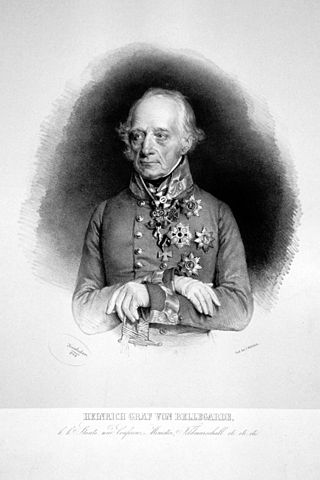
Count Heinrich von Bellegarde, Viceroy of Lombardy-Venetia, of a noble Savoyard family, was born in Saxony, joined the Saxon army and later entered Habsburg military service, where he became a general officer serving in the Habsburg border wars, the French Revolutionary Wars and the Napoleonic Wars. He became a Generalfeldmarschall and statesman.

The Battle of Wavre was the final major military action of the Hundred Days campaign and the Napoleonic Wars. It was fought on 18–19 June 1815 between the Prussian rearguard, consisting of the Prussian III Corps under the command of General Johann von Thielmann and three corps of the French army under the command of Marshal Grouchy. A blocking action, this battle kept 33,000 French soldiers from reaching the Battle of Waterloo and so helped in the defeat of Napoleon at Waterloo.
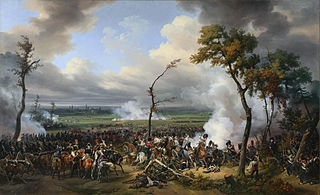
The Battle of Hanau was fought from 30 to 31 October 1813 between Karl Philipp von Wrede's Austro-Bavarian corps and Napoleon's retreating French during the War of the Sixth Coalition.

The Battle of Sehested was fought on 10 December 1813 during the Dano-Swedish War of 1813–1814 between a Dano-Norwegian army under Prince Frederik of Hesse and a Coalition force led by Ludwig von Wallmoden-Gimborn. Near Sehested, Holstein, Frederik's troops defeated the Coalition army, inflicting over 1,100 casualties on von Wallmoden-Gimborn's force while suffering only 500. However, this victory did not prevent the Coalition from emerging victorious in the conflict in 1814.

Johann Adolf, Freiherr von Thielmann was a Saxon general who served with Saxony, Prussia and France during the Napoleonic Wars.

Michael von Kienmayer was an Austrian general. Kienmayer joined the army of the Habsburg monarchy and fought against the Kingdom of Prussia and Ottoman Turkey. During the French Revolutionary Wars, he continued to make his reputation in the cavalry and became a general officer. In the War of the Second Coalition and the Napoleonic Wars he commanded both divisions and corps. He was appointed Proprietor (Inhaber) of an Austrian cavalry regiment in 1802 and held this honor until his death. Later he was the governor of Galicia, Transylvania, and Moravia.
The Battle of Gefrees was fought on 8 July 1809 during the War of the Fifth Coalition between a joint force of Austrians and Brunswickers under the command of General Kienmayer and a French force under the command of General Junot, Duke of Abrantès. The battle ended in victory for the Austrians who avoided being trapped by Junot and a force of Saxons and Westphalians led by Jérôme Bonaparte, King of Westphalia. After Jérôme's troops were defeated at the Battle of Hof, the Austrians effectively had control over all of Saxony. However the victory was in vain, due to the major Austrian defeat at Wagram and the Armistice of Znaim.
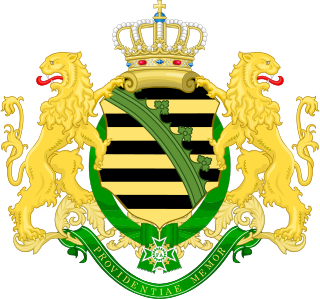
The Royal Saxon Army was the military force of the Electorate (1682–1807) and later the Kingdom of Saxony (1807–1918). A regular Saxon army was first established in 1682 and it continued to exist until the abolition of the German monarchies in 1918. With the formation of the Confederation of the Rhine by Napoleon the Royal Saxon Army joined the French "Grande Armée" along with 37 other German states.

The Battle of Schleiz took place on 9 October 1806 in Schleiz, Germany between a Prussian-Saxon division under Bogislav Friedrich Emanuel von Tauentzien and a part of Jean-Baptiste Bernadotte's I Corps under the command of Jean-Baptiste Drouet, Comte d'Erlon. It was the first clash of the War of the Fourth Coalition, part of the Napoleonic Wars. As Emperor Napoleon I of France's Grande Armée advanced north through the Franconian Forest it struck the left wing of the armies belonging to the Kingdom of Prussia and the Electorate of Saxony, which were deployed on a long front. Schleiz is located 30 kilometers north of Hof and 145 kilometers southwest of Dresden at the intersection of Routes 2 and 94.
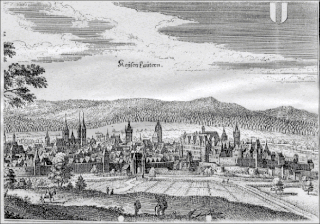
The Battle of Kaiserslautern saw a Coalition army under Charles William Ferdinand, Duke of Brunswick-Wolfenbüttel oppose a Republican French army led by Lazare Hoche. Three days of conflict resulted in a victory by the Prussians and their Electoral Saxon allies as they turned back repeated French attacks. The War of the First Coalition combat was fought near the city of Kaiserslautern in the modern-day state of Rhineland-Palatinate, Germany, which is located about 60 kilometres (37 mi) west of Mannheim.
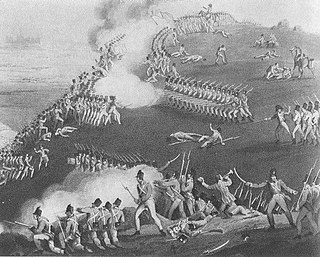
In the Battle of Castalla on 13 April 1813, an Anglo-Spanish-Sicilian force commanded by Lieutenant General Sir John Murray fought Marshal Louis Gabriel Suchet's French Army of Valencia and Aragon. Murray's troops successfully repelled a series of French attacks on their hilltop position, causing Suchet to retreat. The action took place during the Peninsular War, part of the Napoleonic Wars. Castalla is located 35 kilometers north-northwest of Alicante, Spain.

The Battle of Luckau was fought at Luckau in Brandenburg on 4 June 1813 during the War of the Sixth Coalition. Prussian and Russian forces under General Friedrich Wilhelm von Bülow defeated part of a French-Allied corps under Marshal Nicolas Oudinot.

Johann Josef Cajetan Graf von Klenau, Freiherr von Janowitz was a field marshal in the Habsburg army. Klenau, the son of a Bohemian noble, joined the Habsburg military as a teenager and fought in the War of Bavarian Succession against Prussia, Austria's wars with the Ottoman Empire, the French Revolutionary Wars, and the Napoleonic Wars, in which he commanded a corps in several important battles.
The III Cavalry Corps of the Grande Armée was a French military unit that existed during the Napoleonic Wars. The corps was created in 1812 and reconstituted in 1813 and 1815. Emperor Napoleon Bonaparte first mobilized the corps for the invasion of Russia. Commanded by General Emmanuel de Grouchy, two divisions of the corps fought at Borodino, Tarutino, and Vyazma. A third division fought at the First and Second battles of Polotsk and the Berezina. During the War of the Sixth Coalition in 1813, General Jean-Toussaint Arrighi de Casanova led the corps at Großbeeren, Dennewitz, Leipzig, and Hanau.
The IV Cavalry Corps of the Grande Armée was a French military unit that existed during the Napoleonic Wars. The corps was created in 1812 and rebuilt in 1813 and 1815. Emperor Napoleon I first organized the corps for the invasion of Russia. Under General Victor de Fay de La Tour-Maubourg, the corps fought at Borodino. During the War of the Sixth Coalition in 1813, General François Étienne de Kellermann commanded the all-Polish corps at Leipzig.

The raid at Altenburg on 28 September 1813 took place during the War of the Sixth Coalition's German Campaign of 1813. The raid was carried out by the Streifkorp under the command of Saxon General Johann von Thielmann commanding seven regiments of Cossacks, a squadron each of Saxon Hussars and Dragoons, and a detachment of Saxon Freikorps numbering about 1,500 cavalry. The objective of the raid was to attempt harassment of the French lines of communication 25 miles (45 km) south of Leipzig shortly before the Battle of Leipzig. The Austrian contingent was commanded by Emmanuel Mensdorff and the Russian contingent of Cossacks by Matvei Platov.
The Battle of Courtrai saw Johann von Thielmann's Saxon troops and a few Prussians encounter an Imperial French force under Nicolas Joseph Maison near Kortrijk (Courtrai), a city south-west of Ghent in what is now Belgium. Thielmann attacked only to find himself facing the bulk of Maison's I Corps. The action ended in a rout of the Saxons, most of whom were under fire for the first time.

Pierre Barrois became a French division commander during the Napoleonic Wars. He joined a volunteer battalion in 1793 that later became part of a famous light infantry regiment. He fought at Wattignies, Fleurus, Aldenhoven, Ehrenbreitstein and Neuwied in 1793–1797. He fought at Marengo in 1800. He became colonel of a line infantry regiment in 1803 and led it at Haslach, Dürrenstein, Halle, Lübeck and Mohrungen in 1805–1807. Promoted to general of brigade, he led a brigade at Friedland in 1807.















